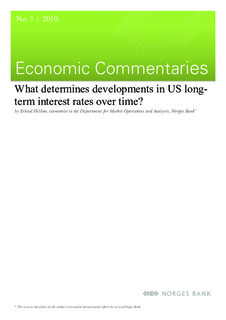| dc.contributor.author | Hellum, Erlend | |
| dc.date.accessioned | 2018-08-23T07:48:45Z | |
| dc.date.available | 2018-08-23T07:48:45Z | |
| dc.date.issued | 2010 | |
| dc.identifier.uri | http://hdl.handle.net/11250/2558982 | |
| dc.description.abstract | This report analyses developments in long-term interest rates in the US. We estimate a model where developments in US long-term interest rates are decided by short-term interest rates, long-term inflation expectations, the ISM index (as a proxy for the output gap), and the current account balance as a percentage of GDP. A larger US current account deficit seems to coincide with lower US long-term interest rates. One explanation might be that the US current account deficit reflects the trade surplus in the rest of the world, and that the savings surplus outside the US lowers long-term interest rates, rendering support to Bernanke’s “savings glut”-hypothesis. | nb_NO |
| dc.language.iso | eng | nb_NO |
| dc.publisher | Norges Bank | nb_NO |
| dc.relation.ispartofseries | Economic Commentaries;3/2010 | |
| dc.rights | Attribution-NonCommercial-NoDerivatives 4.0 Internasjonal | * |
| dc.rights.uri | http://creativecommons.org/licenses/by-nc-nd/4.0/deed.no | * |
| dc.title | What Determines Developments in Us Long-Term Interest Rates over Time? | nb_NO |
| dc.type | Others | nb_NO |
| dc.description.version | publishedVersion | nb_NO |
| dc.subject.nsi | VDP::Samfunnsvitenskap: 200::Økonomi: 210::Samfunnsøkonomi: 212 | nb_NO |
| dc.source.pagenumber | 4 | nb_NO |

